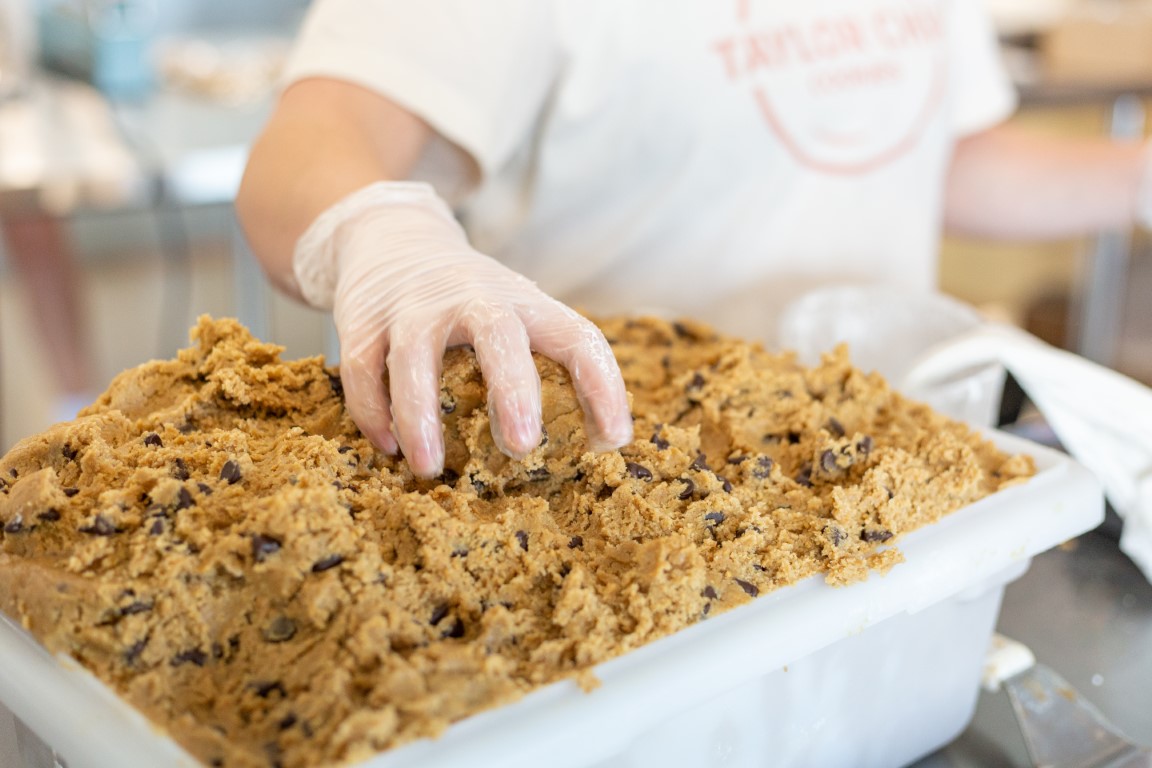To store cookie dough, keep it in an airtight container to prevent drying and maintain freshness. Refrigerate homemade or traditional dough for up to a week, enhancing flavor and texture. For long-term storage, freeze portioned dough on a baking sheet, then transfer to resealable bags, labeling with the date. Always thaw dough in the refrigerator overnight to retain its quality. Avoid leaving dough at room temperature for long periods to prevent bacterial growth. By following these steps, you'll guarantee your cookie dough remains flavorful and safe, ready to bake whenever you crave fresh cookies. Uncover more techniques for ideal preservation next.
Key Takeaways
- Store cookie dough in airtight containers to maintain freshness and prevent drying out.
- Refrigerate homemade dough for up to a week and chilled dough for up to 3 days.
- Freeze portioned dough on a baking sheet before transferring to resealable bags for long-term storage.
- Label and date stored dough to keep track of freshness and type.
- Thaw frozen dough in the refrigerator overnight for best baking results.
Understanding Cookie Dough
Understanding cookie dough starts with knowing the types and ingredients involved. You'll encounter various types, such as chocolate chip, sugar, and oatmeal, each requiring specific ingredients to achieve their unique textures and flavors. Key ingredients typically include flour, sugar, butter, and eggs, but variations might add nuts, chocolate chunks, or spices to enhance the dough's character.
Types and Ingredients
When it comes to cookie dough, there's a surprising variety to take into account, each with its unique set of ingredients. The types of cookie dough you might encounter include homemade cookie dough, refrigerated dough, and frozen cookie dough. Each type requires specific storage methods to maintain freshness and quality.
Homemade cookie dough often contains all-natural ingredients like flour, sugar, eggs, and butter. This dough is best stored in an airtight container in the refrigerator for short-term use, typically up to a week. If you plan to keep it longer, freezing the dough is recommended. Frozen cookie dough can last several months if properly sealed in an airtight container or plastic wrap.
Refrigerated dough, often found in grocery stores, is pre-made and ready to bake. This dough should stay in its original packaging or be transferred to an airtight container to prevent it from drying out.
Frozen cookie dough, available in pre-portioned pieces, offers convenience for quick baking. Confirm it remains in an airtight container to avoid freezer burn.
Understanding these types and ingredients helps in choosing the right storage method, confirming your cookie dough stays fresh and ready for baking whenever you need it.

Choose Your Own Delightfully Perfect Cookies.
With almost 30 flavors to choose from, you can make your box as unique as you are.
Importance of Proper Storage
Proper storage of cookie dough is essential because it directly affects the flavor, texture, and safety of your cookies. When stored correctly, the dough maintains its intended taste and consistency, ensuring the best baking results. Additionally, proper storage prevents harmful bacteria growth, keeping your treats safe to eat.
Impact on Flavor, Texture, and Safety
Storing cookie dough correctly plays an important role in preserving its flavor, texture, and ensuring safety. If you don't store your dough properly, you risk compromising its quality and even your health. For frozen dough, using the right storage method is vital. A zip-top bag can help maintain freshness and prevent freezer burn, which can alter the dough's texture and flavor. Proper storage can also extend the shelf life of your dough, allowing you to bake fresh cookies at your convenience.
When freezing cookie dough, remember these key points:
- Use airtight containers: This prevents exposure to air, which can cause freezer burn.
- Label and date: Always mark the date you stored the dough to keep track of its shelf life.
- Portion your dough: Dividing the dough into portions can reduce bake time and make it easier to thaw.
- Avoid temperature fluctuations: Keep your freezer at a consistent temperature to maintain the dough's quality.
Refrigeration Method
Refrigerating your cookie dough not only preserves its freshness but also enhances the flavor and texture of your cookies. Start by tightly wrapping the dough in plastic wrap or storing it in an airtight container, then place it in the fridge. For best results, chill the dough for at least 1-2 hours, but you can refrigerate it for up to 72 hours if needed.
Benefits and Process
When you refrigerate cookie dough, you release several benefits that enhance your baking game. Refrigeration helps the dough firm up, making it easier to handle and shape. Additionally, chilling the dough allows the flavors to meld together more effectively, resulting in tastier cookies. Furthermore, it can prevent the cookies from spreading too much during baking, ensuring a perfect texture.
To begin the process, consider forming your dough into cookie dough balls before refrigeration. This step simplifies portioning and baking later on. Lay the cookie dough balls on a baking sheet lined with parchment paper, ensuring they don't touch each other. Once the dough balls are firm, transfer them to a resealable freezer bag for longer storage. This method is particularly useful for homemade doughs, allowing you to bake fresh cookies at your convenience.
Here are some key points to remember:
- Flavors meld more effectively: Refrigeration enhances the dough's taste.
- Prevents excessive spreading: Chilled dough maintains its shape better.
- Easier handling: Firm dough is simpler to portion and bake.
- Convenience: Store frozen cookie dough balls for quick baking later.
Recommended Chilling Times
While the benefits of refrigerating cookie dough are clear, it's important to understand how long to chill it for ideal results. Generally, you should refrigerate cookie dough for a minimum of one hour, but overnight chilling is often recommended. This allows the dough to firm up, making it easier to handle and shape. Additionally, chilling helps develop the flavors, giving your cookies a richer taste.
Start by wrapping your cookie dough tightly in plastic wrap to prevent it from drying out or absorbing other refrigerator odors. Alternatively, you can portion the dough into balls and place them on a baking sheet lined with sheets of parchment paper. This method is particularly useful if your cookie dough recipe calls for scooped portions.
For long-term storage, transfer the dough balls to freezer containers after they've chilled for a few hours. Make sure to separate layers with sheets of parchment paper to prevent them from sticking together. When you're ready to bake, simply thaw the dough in the refrigerator until it's soft enough to shape or place directly on a baking sheet for thicker cookies.
Freezing Method
For a long-term storage solution, freezing your cookie dough is an excellent choice. First, you'll need to prepare the dough by portioning it into individual balls or logs, ensuring it's wrapped tightly to prevent freezer burn. When you're ready to bake, thaw the dough in the refrigerator overnight for the best results.
Long-Term Storage Solution
Ever wondered how to keep your cookie dough fresh and ready for baking at a moment's notice? The freezing method is an excellent long-term storage solution. By freezing your batch of cookie dough, you can guarantee that it's preserved and ready to bake whenever you have a craving for fresh cookies. This method works just as well for homemade dough as it does for store-bought cookie dough.
To get started, portion your dough into individual servings. This makes it easy to bake just a few cookies at a time. Place the portions on a baking sheet lined with wax paper, making sure they don't touch each other. Freeze them for a few hours until they're solid. Once frozen, transfer the dough balls into a resealable plastic bag, removing as much air as possible to prevent freezer burn.
Benefits of Freezing Cookie Dough
- Convenience: Having frozen cookies ready to bake saves time.
- Freshness: Dough maintains its quality and flavor.
- Portion Control: Bake only what you need.
- Longevity: Extends the shelf life of your dough.
Using this long-term storage solution, you can enjoy homemade cookies anytime, without the hassle of making dough each time.
Preparation and Best Practices
Preparation and best practices for freezing cookie dough involve a few simple yet essential steps to guarantee ideal results. Start by preparing your cookie dough according to your recipe. Once the dough is ready, portion it into individual servings using a cookie scoop or spoon. This step guarantees that your dough is easier to manage and bake later.
Next, place the portioned dough on a baking sheet lined with parchment paper, guaranteeing the pieces don't touch. Freeze the baking sheet for one to two hours or until the dough is firm. This initial freezing prevents the dough pieces from sticking together when stored.
After the dough is firm, transfer the portions into a resealable freezer bag or airtight container. Label the container with the date and type of cookie dough for easy identification. Removing as much air as possible from the bag or container helps prevent freezer burn and maintains the dough's quality.
For leftover dough, follow the same preparation steps. By adhering to these best practices, you'll guarantee your dough before baking remains fresh and ready for use whenever you crave homemade cookies.
Thawing Techniques
Once your cookie dough is properly frozen, you'll need to know the best ways to thaw it before baking. Thawing raw cookie dough requires some planning, but it's simple with a few extra steps. For cut-out cookie dough, it's vital to preserve its shape and consistency. Start by removing the dough from the freezer and wrapping it in deli paper. This helps prevent condensation from making the dough too sticky.
Place the wrapped dough in the refrigerator to thaw slowly. This method can take several hours, so plan accordingly. If you're short on time, you can leave the wrapped dough at room temperature for a faster thaw, but be cautious as it might soften too much.
Here are some key points to remember when thawing cookie dough:
- Refrigerator Thawing: Best for maintaining dough texture, takes several hours.
- Room Temperature Thawing: Faster but riskier, monitor closely.
- Deli Paper: Prevents condensation, preserves dough quality.
- Extra Steps: Confirm proper wrapping and monitoring for best results.
Once thawed, you may need to add a few minutes of baking time since the dough might still be slightly cold. Proper thawing techniques guarantee your cookies bake evenly and taste delicious.
Storing Different Types of Cookie Dough
When storing cookie dough, you need to contemplate whether you're working with traditional or edible cookie dough. Traditional cookie dough contains raw eggs and flour, which can harbor bacteria, so it must be kept refrigerated or frozen to prevent spoilage. On the other hand, edible cookie dough is specifically made without raw eggs and heat-treated flour, allowing it to be stored at room temperature for short periods, although refrigeration can extend its shelf life.
Traditional vs. Edible Cookie Dough
Understanding how to store traditional and edible cookie dough guarantees you get the best results when you're ready to bake or snack. Traditional cookie dough contains raw ingredients like eggs and flour, which can lead to food poisoning if consumed raw. Consequently, it's essential to store traditional cookie dough properly to make sure it's safe for baking later.
To store traditional cookie dough:
- Refrigerate: Keep it in the fridge for up to three days.
- Freeze: Place dough ready for baking in the freezer for up to three months.
- Wrap tightly: Use plastic wrap or airtight containers to avoid contamination.
- Label: Clearly mark the date and type of dough to track freshness.
On the other hand, edible cookie dough is designed to be eaten without baking and typically lacks raw eggs and untreated flour, reducing the risk of foodborne illnesses. For edible cookie dough, refrigeration is usually sufficient to maintain freshness, and it can also be frozen for longer storage if needed. When handling either type, always make sure your hands and utensils are clean to prevent any contamination. By following these guidelines, you'll have delicious, safe cookie dough ready for baking or eating whenever the craving hits.
Identifying Spoilage and Storage Tips
To keep your cookie dough fresh and safe to eat, it's essential to identify signs of spoilage, such as changes in color, texture, or smell. Use airtight containers or plastic wrap to store the dough, and always keep it refrigerated or frozen. By following these practices, you'll guarantee your cookie dough remains in ideal condition for baking.
Signs of Spoilage
Spotting spoilage in cookie dough can save you from a disappointing baking session. Knowing the signs of spoilage will guarantee you only bake fresh cookies, giving you the best results. Here's what you need to look for:
- Discolored edges: Fresh dough should have a uniform color. If you notice any darkening or unusual spots, it's a clear sign the dough is past its prime.
- Off odor: A sour or strange smell indicates fermentation or bacterial growth, meaning it's time to toss it.
- Texture changes: Dough that has become overly dry or excessively sticky might have deteriorated, affecting the final texture of individual cookies.
- Mold: Any visible mold growth, regardless of the type of cookie dough, is a definitive sign of spoilage.
When you're preparing to store cookie dough, shape the dough into balls for easier portioning later. This helps in maintaining even baking and guarantees each cookie comes out perfectly. Always check for these spoilage signs before baking to avoid wasted effort and ingredients. By keeping an eye out for discoloration, odd smells, texture changes, and mold, you'll guarantee every batch of cookies you bake is fresh and delicious.
Optimal Storage Containers and Practices
When it comes to storing cookie dough, choosing the right container and following proper practices can make all the difference in maintaining its freshness. First, consider using airtight containers to prevent your dough from drying out. For types of cookies that require chilling, like sugar or chocolate chip, you can roll the dough into balls of dough and place them on a cookie sheet. Once frozen, transfer them to a sealable plastic bag, guaranteeing no air remains inside. This method not only saves space but also lets you bake a few cookies at a time without thawing the entire batch.
For those following specific cookie recipes, always check the baking instructions for any unique storage advice. Some doughs, like that for delicate shortbread, might need particular handling. Label your containers with the type of cookie and the date you made the dough. This helps you keep track and use the dough before it spoils. If you notice any off smells, discoloration, or changes in texture, discard the dough immediately. Remember, proper storage practices guarantee your cookies taste fresh and delicious, just as you intended when you first whipped up the dough.
Why Trust Our Cookie Dough Insights?
At Taylor Chip, our expertise in cookie dough isn't just about following recipes – it's a passion that's been baked into our very foundation. Since 2015, Sara and Dougie Taylor have been on a sweet journey of perfecting the art of cookie making. What started as a fun date night activity quickly evolved into a shared obsession, leading to countless hours of experimentation and refinement in the kitchen.
Our journey to cookie perfection wasn't just about creating delicious treats; it was about understanding the science behind cookie dough. Through years of hands-on experience, we've gained invaluable insights into the intricacies of dough composition, storage techniques, and baking methods. This expertise allows us to provide you with tried-and-true advice on how to store and handle your cookie dough for the best results. Whether you're a home baker or a cookie enthusiast, our tips come from a place of genuine passion and practical experience, ensuring that you can trust our guidance to help you achieve cookie perfection in your own kitchen.
Frequently Asked Questions
Can Cookie Dough Be Stored in Silicone Bags?
Yes, you can store cookie dough in silicone bags. They're a great option because they're reusable and airtight, keeping your dough fresh. Just make sure to seal them well and store them in the fridge or freezer.
How Long Can Cookie Dough Stay at Room Temperature?
You shouldn't leave cookie dough at room temperature for more than two hours. Bacteria can grow rapidly at room temperature, making the dough unsafe to eat. Store it in the fridge or freezer to keep it fresh.
Does Cookie Dough Need to Be Covered When Stored?
Yes, you should cover cookie dough when storing it. Covering prevents it from drying out and protects it from absorbing unwanted odors. Use plastic wrap or an airtight container to keep it fresh and ready to bake.
Can I Add Toppings Before Storing Cookie Dough?
You can add toppings before storing cookie dough, but it's better to wait. Toppings might get soggy or affect texture during storage. Add them just before baking for the best results.
Is It Safe to Eat Raw Refrigerated Cookie Dough?
It's usually not safe to eat raw refrigerated cookie dough because it contains raw eggs and flour, both of which can harbor harmful bacteria. If you really want to indulge, look for dough specifically labeled safe to eat raw.
Conclusion
To guarantee your cookie dough stays fresh and safe to eat, always store it properly. Use refrigeration for short-term storage and freezing for long-term preservation. Be mindful of the specific storage needs of different types of cookie dough, and regularly check for signs of spoilage such as changes in color, texture, or smell. By following these guidelines, you'll maintain the quality and flavor of your cookie dough, ready for baking whenever you desire.







